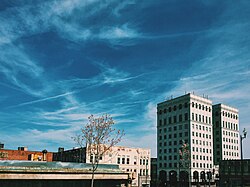Danville, VA
| Danville, Virginia | ||
|---|---|---|
| Independent city | ||

View of Downtown looking North
|
||
|
||
| Nickname(s): River City, City of Churches |
||
| Motto: The River City, Where Innovation Flows | ||
| Location in the state of Virginia | ||
| Coordinates: 36°35′14″N 79°24′16″W / 36.58722°N 79.40444°WCoordinates: 36°35′14″N 79°24′16″W / 36.58722°N 79.40444°W | ||
| Country | United States | |
| State | Virginia | |
| County | None (Independent city) | |
| Government | ||
| • Mayor | Sherman Saunders | |
| Area | ||
| • Total | 43.9 sq mi (113.8 km2) | |
| • Land | 42.9 sq mi (111.2 km2) | |
| • Water | 1.0 sq mi (2.6 km2) | |
| Elevation | 531 ft (162 m) | |
| Population (2010) | ||
| • Total | 43,055 | |
| • Density | 1,004/sq mi (388/km2) | |
| Demonym(s) | Danvillian | |
| Time zone | EST (UTC-5) | |
| • Summer (DST) | EDT (UTC-4) | |
| Area code(s) | 434 | |
| FIPS code | 51-21344 | |
| GNIS feature ID | 1492837 | |
| Website | www |
|
Danville is an independent city in the Commonwealth of Virginia. As of the 2010 census, the population was 43,055. It is bounded by Pittsylvania County, Virginia and Caswell County, North Carolina. It hosts the Danville Braves baseball club of the Appalachian League.
Danville is the principal city of the Danville, Virginia Micropolitan Statistical Area.
Numerous Native American tribes had lived in this part of the Piedmont region since prehistoric times. During the colonial period, the area was inhabited by Siouan language-speaking tribes.
In 1728, English colonist William Byrd headed an expedition sent to determine the true boundary between Virginia and North Carolina. One night late that summer, the party camped upstream from what is now Danville, Byrd was so taken with the beauty of the land, that he prophesied a future settlement in the vicinity, where people would live "with much comfort and gaiety of Heart." The river along which he camped was named the "Dan", for Byrd, supposing himself to be in the land of plenty, felt he had wandered "from Dan to Beersheba."
The first European-American settlement developed in 1792 downstream from Byrd's campsite, at a spot along the river shallow enough to allow fording. It was named "Wynne's Falls", after the first settler. The village had a "social" reason for its origin, growing from the meetings of pioneering Revolutionary War veterans, who gathered annually to fish and talk over old times.
...
Wikipedia


